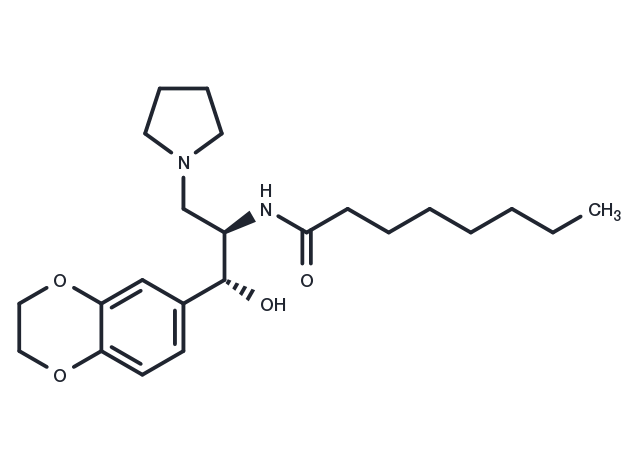Powder: -20°C for 3 years | In solvent: -80°C for 1 year


Eliglustat (Genz 99067) is an oral inhibitor of glucosylceramide synthase which is used in the therapy of type 1 Gaucher disease.

| Pack Size | Availability | Price/USD | Quantity |
|---|---|---|---|
| 1 mg | In stock | $ 52.00 | |
| 2 mg | In stock | $ 68.00 | |
| 5 mg | In stock | $ 96.00 | |
| 10 mg | In stock | $ 126.00 | |
| 25 mg | In stock | $ 193.00 | |
| 50 mg | In stock | $ 252.00 | |
| 100 mg | In stock | $ 468.00 | |
| 500 mg | In stock | $ 1,050.00 | |
| 1 mL * 10 mM (in DMSO) | In stock | $ 85.00 |



| Description | Eliglustat (Genz 99067) is an oral inhibitor of glucosylceramide synthase which is used in the therapy of type 1 Gaucher disease. |
| Targets&IC50 | glucosylceramide synthase (GCS):20 nM |
| In vitro | Eliglustat Tartrate is rapidly metabolized within the bodies of rodents, exhibiting a half-life of 15-45 minutes. Administration of Eliglustat Tartrate to normal mice, rats, and dogs, either through intravenous injection or orally, significantly reduces the levels of glucosylceramide in the spleen, kidneys, and liver. |
| In vivo | Eliglustat tartrate is an inhibitor of glucosylceramide synthase, exhibiting high specificity towards this enzyme, and has limited to no inhibitory activity against a wide range of other glycosidases. |
| Kinase Assay | Smo-binding assays are conducted with BODIPY-cyclopamine and Smo-overexpressing HEK 293T cells, using a CMVpromoter-based SV40 origin-containing expression construct for Smo-Myc3 (murine Smo containing three consecutive Myc epitopes at the C terminus). HEK 293T cells are seeded into eight-well chambered coverslips (80,000 cells/well) and cultured in DMEM containing 10% FBS, 100 U/mL penicillin, and 0.1 mg/mL streptomycin. The cells are cultured until they reached 55 to 65% confluency (14-18 h), after which they are transfected with the Smo-Myc3 expression construct and Transit-LT1. Twenty-four hours after transfection, the cells are washed with PBS and cultured in DMEM containing 0.5% FBS, 5 nM BODIPY-cyclopamine, and various concentrations of either cyclopamine or individual HPIs. After 30 min, 10 μM Hoescht 33342 is added to each well, and the HPIs are incubated with the cells for an additional 30 min. The cells are then washed two times with PBS buffer, once with phenol red-free DMEM containing 0.5% FBS, and immediately imaged using a DMI6000B compound microscope. Images are background-substracted using ImageJ software with a rolling ball size of 75 pixels, and BODIPY-cyclopamine intensity is then determined using Metamorph software. Circular regions with a diameter of 300 pixels are placed over regions containing uniformly confluent cells, and the pixel intensities of approximately 20 regions from four independent images is used to determine the average BODIPY-cyclopamine levels for each experimental condition[1]. |
| Cell Research | The inhibitory activity of Genz-112638 is determined indirectly by measuring its effect on the cell surface levels of the gangliosides GM1 and GM3 on either K562 or B16/F10 cells. GM1 levels on the K562 cells are determined by incubating the cells with increasing amounts of Genz-112638 (0.6-1000 nM) for 72 h after which the cells are harvested and stained using 10 μg of recombinant cholera toxin-FITC in 100 μL phosphate buffered saline (PBS) containing 0.5% bovine serum albumin (BSA) for 30 min on ice. Cells are ished, resuspended in PBS containing 0.5% BSA and the fluorescence quantitated[1]. |
| Synonyms | GENZ-112638, Genz 99067 |
| Molecular Weight | 404.54 |
| Formula | C23H36N2O4 |
| CAS No. | 491833-29-5 |
Powder: -20°C for 3 years | In solvent: -80°C for 1 year
Ethanol: 74 mg/mL (182.9 mM)
DMSO: 74 mg/mL (182.9 mM)
H2O: < 1 mg/mL (insoluble or slightly soluble)
You can also refer to dose conversion for different animals. More
bottom
Please see Inhibitor Handling Instructions for more frequently ask questions. Topics include: how to prepare stock solutions, how to store products, and cautions on cell-based assays & animal experiments, etc.
Eliglustat 491833-29-5 Metabolism Transferase inhibit GENZ-112638 Genz-99067 GENZ112638 Inhibitor Genz 99067 GENZ 112638 Genz99067 inhibitor
